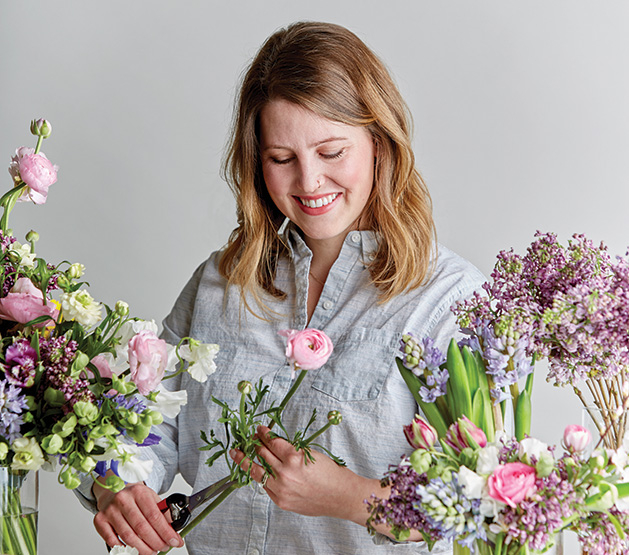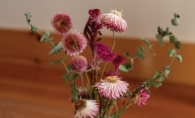
To the untrained eye, arranging a floral bouquet might sound like an easy task. Pick up a bouquet from the local grocery store and arrange the blooms any which way in any vase, right? Not exactly.
“You need to purposely place every flower in your arrangement,” says Marie Raley, owner of Laine Moire floral design. Raley has been working with blooms for 10 years, a skill she first picked up while designing the bouquets for her own DIY wedding.
“I got married in the fall, and we wanted to keep things seasonal,” Raley says. In lieu of using traditional roses or tulips, Raley opted for mosses and grasses that are native to Minnesota and were in season in the fall. After her wedding was featured in Minnesota Bride magazine, Raley realized she had a knack for fixing up flowers. “I thought, ‘I guess I’m kind of good at this,’” she says. Now, Raley is the owner and lead designer for Laine Moire, and she does everything from styling weddings to hosting DIY workshops for hobby florists.
As spring begins again, you might want to add the season’s new blooms to your kitchen counters or as centerpieces at your garden party. We asked Raley to share her tips with us for a fail-safe floral arrangement you can make at home.
“Spring can be tricky because, in Minnesota, it can start whenever,” Raley says. Despite the fickle weather, Raley says there are blooms that can typically be found around this time of year and are traditionally associated with the spring season. “Tulips, ranunculus, anemones and hellebores are seasonal blooms across the continental U.S.,” she says, noting that bulb flowers are typically a good bet for the spring.
Raley also mentions that anyone hoping to begin creating floral arrangements of their own should look through their tool shed to make sure they have all the proper gear. “If you don’t use the right ones from the start, your arrangement won’t last very long,” Raley says. She recommends investing in a pair of good, clean floral shears with sharp blades. Don't reach for a pair of regular scissors; Raley says the blades simply aren’t sharp enough. “[It’s] the worst thing to use to cut a flower,” she explains. When cutting flowers, stems should always be sliced at a 45-degree angle instead of straight across—it ensures the vascular system of the stem remains open and is able to receive water and food.
For hands-on learners, Raley’s expertise doesn’t end with her own arrangements. She also offers courses through Minnetonka Community Education, with spring classes including how-tos for corsages, boutonnieres and flower crowns for prom season in April, and a class on hand-tied bouquets for Mother’s Day in May.
Ultimately, Raley wants to make floral arranging something people can be passionate about again, noting the growing interest in DIY projects. “I want to bring flowers into the home and have people growing gardens,” she says. “I want to make floral arrangements something people do again.”
Laine Moire Floral Design
612.940.3025
Shop open by appointment only.
Facebook: Laine Moire
Instagram: @lainemoire









